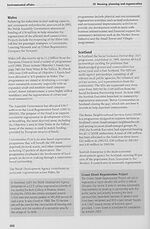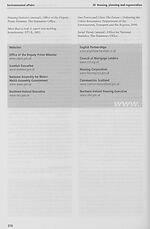Download files
Complete book:
Individual page:
Thumbnail gallery: Grid view | List view

Environmental affairs
20 Housing, planning and regeneration
in Scotland through a number of schemes such as
the Crown Street Regeneration Project.
Communities Scotland also has a responsibility
for regeneration. It works closely with a number
of partners, in particular local authorities. The
planned budget for Communities Scotland for
2002/03 is over £300 million, of which £80 million
is specifically for regeneration schemes.
Communities Scotland plans to invest £65 million in
housing regeneration projects in Glasgow in
2002/03. The funding will be targeted at Glasgow's
nine priority areas for regeneration - the SIP areas -
and will provide new terraced homes with gardens
for people living in poor quality tenement flats.
Funding of £5 million will also be targeted at
improving poor housing in areas where there are
large minority ethnic communities.
Northern Ireland
The Department for Social Development (DSD)
administers the Urban Development Grant
(UDG) scheme, which promotes job creation,
inward investment and environmental
improvement in priority areas of Belfast and
Londonderry/Derry by stimulating the
development of vacant, derelict or underused land
or buildings. In Belfast, priority is currently given
to schemes within those deprived areas covered by
the Belfast Regeneration Office, while UDG in
Londonderry/Derry is targeted at the City Centre
and Waterside Business District. Outside the two
major cities the Department runs the Urban
Development Programme on behalf of the
International Fund for Ireland. It has similar aims
to UDG and is available within existing
commercial areas of towns and villages.
£2.7 million and from its launch in 1988 to the
end of 2001/02 provided £36 million for a variety
of projects in the most deprived and
disadvantaged areas.
The Community Regeneration and Improvement
Special Programme (CRISP), which is jointly
funded by DSD and the International Fund for
Ireland, is aimed at assisting community-led
regeneration in the most disadvantaged smaller
towns and villages in Northern Ireland. CRISP
provides a financial package of measures to deliver
economic, physical and social benefits to these
deprived communities. Since 1990 over 72
projects have been approved with funding of over
£56 million.
The Community Property Development Scheme
and Second Community Projects form part of the
International Fund for Ireland’s Urban
Development Programme in Northern Ireland.
The primary objective of these schemes is to
stimulate economic activity by encouraging cross¬
community groups to regenerate key properties in
the most rundown areas outside Belfast and
Londonderry/Derry. Twenty projects have been
approved under this scheme with grants totalling
£5.5 million.
The Rural Development Programme in Northern
Ireland began in 1991. In 2001 the NIHE
announced the 2001-06 phase of the programme,
which seeks to develop social, economic and
cultural initiatives for people living in Northern
Ireland’s rural communities. The programme
targets all parts of Northern Ireland outside the
Metropolitan Area of Belfast, the city of
Londonderry/Derry and the 20 towns with
populations greater than 5,000.
Underused or derelict land and buildings in selected
areas of towns and cities are identified for planning
and regeneration by the DSD via Comprehensive
Development Schemes. It also has responsibility for
the Laganside Corporation, a non-departmental
public body managing the regeneration of Belfast’s
riverside and waterfront areas.
Further reading
Delivering a Fundamental Change. Green Paper.
DTLR, 2001.
DTLR Annual Report 2002: The Government's
expenditure plans 2002-03 to 2003-04. The
Stationery Office, 2002
The Making Belfast Work Initiative had an annual
budget of around £13.7 million and provided
£262 million for a variety of projects between
1988 and the end of 2001/02. The Londonderry
Regeneration Initiative had an annual budget of
English Partnerships: Annual Report and Financial
Statements. English Partnerships.
The Housing Corporation: Annual Review. The
Housing Corporation.
309
20 Housing, planning and regeneration
in Scotland through a number of schemes such as
the Crown Street Regeneration Project.
Communities Scotland also has a responsibility
for regeneration. It works closely with a number
of partners, in particular local authorities. The
planned budget for Communities Scotland for
2002/03 is over £300 million, of which £80 million
is specifically for regeneration schemes.
Communities Scotland plans to invest £65 million in
housing regeneration projects in Glasgow in
2002/03. The funding will be targeted at Glasgow's
nine priority areas for regeneration - the SIP areas -
and will provide new terraced homes with gardens
for people living in poor quality tenement flats.
Funding of £5 million will also be targeted at
improving poor housing in areas where there are
large minority ethnic communities.
Northern Ireland
The Department for Social Development (DSD)
administers the Urban Development Grant
(UDG) scheme, which promotes job creation,
inward investment and environmental
improvement in priority areas of Belfast and
Londonderry/Derry by stimulating the
development of vacant, derelict or underused land
or buildings. In Belfast, priority is currently given
to schemes within those deprived areas covered by
the Belfast Regeneration Office, while UDG in
Londonderry/Derry is targeted at the City Centre
and Waterside Business District. Outside the two
major cities the Department runs the Urban
Development Programme on behalf of the
International Fund for Ireland. It has similar aims
to UDG and is available within existing
commercial areas of towns and villages.
£2.7 million and from its launch in 1988 to the
end of 2001/02 provided £36 million for a variety
of projects in the most deprived and
disadvantaged areas.
The Community Regeneration and Improvement
Special Programme (CRISP), which is jointly
funded by DSD and the International Fund for
Ireland, is aimed at assisting community-led
regeneration in the most disadvantaged smaller
towns and villages in Northern Ireland. CRISP
provides a financial package of measures to deliver
economic, physical and social benefits to these
deprived communities. Since 1990 over 72
projects have been approved with funding of over
£56 million.
The Community Property Development Scheme
and Second Community Projects form part of the
International Fund for Ireland’s Urban
Development Programme in Northern Ireland.
The primary objective of these schemes is to
stimulate economic activity by encouraging cross¬
community groups to regenerate key properties in
the most rundown areas outside Belfast and
Londonderry/Derry. Twenty projects have been
approved under this scheme with grants totalling
£5.5 million.
The Rural Development Programme in Northern
Ireland began in 1991. In 2001 the NIHE
announced the 2001-06 phase of the programme,
which seeks to develop social, economic and
cultural initiatives for people living in Northern
Ireland’s rural communities. The programme
targets all parts of Northern Ireland outside the
Metropolitan Area of Belfast, the city of
Londonderry/Derry and the 20 towns with
populations greater than 5,000.
Underused or derelict land and buildings in selected
areas of towns and cities are identified for planning
and regeneration by the DSD via Comprehensive
Development Schemes. It also has responsibility for
the Laganside Corporation, a non-departmental
public body managing the regeneration of Belfast’s
riverside and waterfront areas.
Further reading
Delivering a Fundamental Change. Green Paper.
DTLR, 2001.
DTLR Annual Report 2002: The Government's
expenditure plans 2002-03 to 2003-04. The
Stationery Office, 2002
The Making Belfast Work Initiative had an annual
budget of around £13.7 million and provided
£262 million for a variety of projects between
1988 and the end of 2001/02. The Londonderry
Regeneration Initiative had an annual budget of
English Partnerships: Annual Report and Financial
Statements. English Partnerships.
The Housing Corporation: Annual Review. The
Housing Corporation.
309
Set display mode to:
![]() Universal Viewer |
Universal Viewer | ![]() Mirador |
Large image | Transcription
Mirador |
Large image | Transcription
The item on this page appears courtesy of Office for National Statistics and may be re-used under the Open Government Licence for Public Sector Information.
| Britain and UK handbooks > UK: The official yearbook of the United Kingdom of Great Britain and Northern Ireland > 2003 > (347) |
|---|
| Permanent URL | https://digital.nls.uk/204927621 |
|---|
| Attribution and copyright: |
|
|---|---|
| Description | Three volumes of 'UK: The official yearbook of the United Kingdom of Great Britain and Northern Ireland', published annually by the Office of National Statistics from 2002-2005. |
|---|---|
| Shelfmark | GII.11 SER |
| Description | Three titles produced by the British Government from 1954-2005 describing 'how Britain worked'. They are: 'Britain: An official handbook' (1954-1998), 'Britain: The official yearbook of the United Kingdom' (1999-2001), and 'UK: The official yearbook of the United Kingdom of Great Britain and Northern Ireland' (2002-2005). These 50 reports provide an overview of Britain's economic, social and cultural affairs, its environment, international relations, and the systems of government. They give an impartial summary of government policies and initiatives, and explain how public services are organised. |
|---|---|
| Additional NLS resources: |
|

